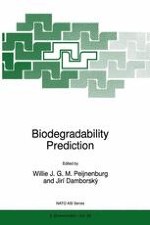1996 | OriginalPaper | Chapter
A Mechanistic Approach to Deriving Quantitative Structure Biodegradablity Relationships
A Case Study: Dehalogenation of Haloaliphatic Compounds
Authors : J. Damborský, K. Manová, M. Kutý
Published in: Biodegradability Prediction
Publisher: Springer Netherlands
Included in: Professional Book Archive
Activate our intelligent search to find suitable subject content or patents.
Select sections of text to find matching patents with Artificial Intelligence. powered by
Select sections of text to find additional relevant content using AI-assisted search. powered by
The application of a mechanistic approach for the study of mechanisms of microbial degradation processes and the development of Quantitative Structure-Biodegradability models are outlined in this contribution. The dehalogenation of haloaliphatic compounds was used as a case study and an attempt was made: (i) to determine the rate-limiting sub-process, (ii) to quantitatively estimate interspecies variability in substrate specificity and (iii) to investigate structure-activity relationships leading towards development of QSBR models.A comparison of dehalogenation rates obtained in testing systems at different organization levels, intact cells and isolated enzyme, revealed that penetration of the halogenated aliphatic compounds into the cells of dehalogenase competent microbes is not the rate limiting step in the hydrolytic dehalogenation. Consequently, the enzymatic reaction is to be considered slower than the penetration process. Multivariate analysis of the substrate profiles of the haloalkane dehalogenases of different microbial strains was performed to tackle the problem of the utility of single species testing for the prediction of environmental rate constants. At least two groups of haloalkane dehalogenases were formulated based on their ability to dehalogenate various haloaliphatic compounds.A preliminary QSBR model for terminally substituted mono- and dihalogenated alkanes was developed. All three types of descriptors: hydrophobicity, steric, and electronic were necessary to obtain a good description of the process studied. Three outliers from the model, all short-chain chlorinated compounds, were detected and the reasons for discrepancy between predictions and observation are discussed. Although more research is needed to better understand structure-biodegradability relationships for hydrolytic dehalogenation, the mechanistic approach is shown to provide beneficial information for model interpretation.
